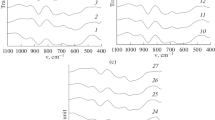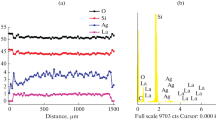Abstract
Composite materials (CMs) based on matrices of high-silica nanoporous glasses (NPGs) activated by bismuth and yttrium ions are synthesized. The CMs are studied by IR spectroscopy (1000–400 cm–1), depending on the Bi/Y nitrate ratio in the solution (1 : 1 and 10 : 1) and the heat treatment temperature of the CMs (from 470 to 870°C). The method of IR spectroscopy in composites identifies vibrations characteristic of the cubic modification Y2O3 and for the monoclinic modification of bismuth oxide (α–Bi2O3); for vibrations of Bi–O and Bi–O–Bi bonds, as well as Bi3+ cations in [BiO6] and/or [Bio3] structural units; and for vibrations of Bi–O–Si bonds, and for Y–O–Y and Y–O bonds. It is established that an increase in the yttrium content in CMs heat-treated at 470 and 870°C, (all other things being equal) leads to the appearance of additional absorption bands at 564, 556, 432, and 424 cm–1, which may be related to the formation of the cubic phase Y2O3.

Similar content being viewed by others
REFERENCES
Liu, X., Staubitz, A., and Gesing, T.M., Thermochromic behavior of yttrium-substituted bismuth oxides, ACS Appl. Mater. Interfaces, 2019, vol. 11, pp. 33147–33156.
Mizoguchi, H., Kawazoe, H., Hosono, H., and Fujitsu, S., Charge transfer band observed in bismuth mixed-valence oxides, Bil–xYxO1.5+δ (x = 0.3), Solid State Commun., 1997, vol. 104, pp. 705–708.
Šulcová, P. and Trojan, M., Thermal analysis of the (Bi2O3)1–x(Y2O3)x pigments, J. Therm. Anal. Calorim., 2008, vol. 91, pp. 151–154.
Watanabe, A., Phase equilibrium in the system Bi2O3-Y2O3: No possibility of δ-Bi2O3 stabilization, Solid State Ionics, 1996, vols. 86–88, pp. 1427–1430.
Wang, S.L., Hu, Z.B., Gao, F., Wang, C.P., and Liu, X.J., Thermodynamic assessments of the Bi–Tb and Bi–Y systems, J. Phase Equilib. Diffus., 2011, vol. 32, pp. 441–446.
Zhen, Q., Kale, G.M., Shi, G., Li, R., He, W., and Liu, J., Processing of dense nanocrystalline Bi2O3-Y2O3 solid electrolyte, Solid State Ionics, 2005, vol. 176, pp. 2727–2733.
Girsova, M.A., Golovina, G.F., Anfimova, I.N., Kurilenko, L.N., and Antropova, T.A., Glass Phys. Chem., 2022, vol. 48, no. 5, pp. 384–393.
Antropova, T., Girsova, M., Anfimova, I., Drozdova, I., Polyakova, I., and Vedishcheva, N., Structure and spectral properties of the photochromic quartz-like glasses activated by silver halides, J. Non-Cryst. Solids, 2014, vol. 401, pp. 139–141.
Antropova, T.V., Girsova, M.A., Anfimova, I.N., Golovina, G.F., Kurilenko, L.N., and Firstov, S.V., Method of luminescent bismuth-containing quartzlike material producing based on high-silica porous glass, RF Patent 2605711, Byull. Izobret., 2016, no. 36.
Reddy, D.V.K., Taherunnisa, Sk., Prasanna, A.L., Rao, T.S., Veeraiah, N., and Reddy, M.R., Enhancement of the red emission of Eu3+ by Bi3+ sensitizers in yttrium alumino bismuth borosilicate glasses, J. Mol. Struct., 2019, vol. 1176, pp. 133–148.
Husung, R.D. and Doremus, R.H., The infrared transmission spectra of four silicate glasses before and after exposure to water, J. Mater. Res., 1990, vol. 5, pp. 2209–2217.
Haritha, A.H. and Rao, R.R., Sol-gel synthesis and phase evolution studies of yttrium silicates, Ceram. Int., 2019, vol. 45, pp. 24957–24964.
Hammad, A.H., Abdelghany, A.M., and ElBatal, H.A., Thermal, structural, and morphological investigations of modified bismuth silicate glass-ceramics, Silicon, 2017, vol. 9, pp. 239–248.
Kundu, R.S., Dult, M., Punia, R., Parmar, R., and Kishore, N., Titanium induced structural modifications in bismuth silicate glasses, J. Mol. Struct., 2014, vol. 1063, pp. 77–82.
Romo, F.C., Murillo, A.G., Torres, D.L., Castro, N.C., Romero, V.H., de la Rosa, E., Febles, V.G., and Hernández, M.G., Structural and luminescence characterization of silica coated Y2O3:Eu3+ nanopowders, Opt. Mater., 2010, vol. 32, pp. 1471–1479.
Cacaina, D., Ylanen, H., Simon, S., and Hupa, M., The behaviour of selected yttrium containing bioactive glass microspheres in simulated body environments, J. Mater. Sci.: Mater. Med., 2008, vol. 19, pp. 1225–1233.
Ardelean, I. and Cora, S., FT-IR, Raman and UV-VIS spectroscopic studies of copper doped 3Bi2O3·B2O3 glass matix, J. Mater. Sci.: Mater. Electron., 2008, vol. 19, pp. 584–588.
Singh, L., Thakur, V., Punia, R., Kundu, R.S., and Singh, A., Structural and optical properties of barium titanate modified bismuth borate glasses, Solid State Sci., 2014, vol. 37, pp. 64–71.
Fuss, T., Moguš-Milanković, A., Ray, C.S., Lesher, C.E., Youngman, R., and Day, D.E., Ex situ XRD, TEM, IR, Raman and NMR spectroscopy of crystallization of lithium disilicate glass at high pressure, J. Non-Cryst. Solids, 2006, vol. 352, pp. 4101–4111.
Dimitrov, V., Dimitriev, Y., and Montenero, A., IR spectra and structure of V2O5–GeO2–Bi2O3 glasses, J. Non-Cryst. Solids, 1994, vol. 180, pp. 51–57.
Shanmugapriya, T., and Balavijayalakshmi, J., Role of graphene oxide/yttrium oxide nanocomposites as a cathode material for natural dye-sensitized solar cell applications, Asia-Pac. J. Chem. Eng., 2021, vol. 16, e2598. https://doi.org/10.1002/apj.2598
Muresan, L.E., Cadis, A.I., Perhaita, I., and Indrea, E., Morpho-structural and luminescence investigations on yttrium silicate based phosphors prepared with different precipitating agents, Centr. Eur. J. Chem., 2014, vol. 12, pp. 1023–1031.
Hajizadeh-Oghaz, M., Razavi, R.S., Barekat, M., Naderi, M., Malekzadeh, S., and Rezazadeh, M., Synthesis and characterization of Y2O3 nanoparticles by sol-gel process for transparent ceramics applications, J. Sol-Gel Sci. Technol., 2016, vol. 78, pp. 682–691.
Tanner, P.A. and Sun, R.W.Y., Use of preformed sols in the synthesis of luminescent lanthanide ion-doped yttria, J. Mater. Sci., 2001, vol. 36, pp. 2253–2255.
McDevitt, N.T. and Baun, W.L., Infrared absorption study of metal oxides in the low frequency region (700–240 cm–1), Spectrochim. Acta, Part A, 1964, vol. 20, pp. 799–808.
Ardelean, I. and Rusu, D., Structural investigations of some B2O3 based glasses, J. Optoelectron. Adv. Mater., 2008, vol. 10, pp. 66–73.
Rejisha, S.R., Anjana, P.S., and Gopakumar, N., Effect of cerium(IV) oxide on the optical and dielectric properties of strontium bismuth borate glasses, J. Mater. Sci.: Mater. Electron., 2016, vol. 27, pp. 5475–5482.
Eniu, D. and Simon, S., Structural properties of melt versus sol-gel derived yttrium aluminosilicate systems, Ceram. Int., 2018, vol. 44, pp. 9581–9584.
Ardelean, I., Cora, S., and Rusu, D., EPR and FT-IR spectroscopic studies of Bi2O3–B2O3–CuO glasses, Phys. B (Amsterdam, Neth.), 2008, vol. 403, pp. 3682–3685.
Teja, P.M.V., Babu, A.R., Rao, P.S., Vijay, R., and Rao, D.K., Structural changes in the ZnF2–Bi2O3–GeO2 glass system doped with Fe2O3 by spectroscopic and dielectric investigations, J. Phys. Chem. Solids, 2013, vol. 74, pp. 963–970.
Funding
This work was supported by the RF Ministry of Science and Higher Education as part of the state assignment of the the Institute of Silicate Chemistry, Russian Academy of Sciences (state registration no. AAAA-A19-119022290087-1 and no. 1021050501068-5-1.4.3 (project FFEM-2022-0004)).
Author information
Authors and Affiliations
Corresponding author
Ethics declarations
The authors declare that they have no conflicts of interest.
Rights and permissions
About this article
Cite this article
Girsova, M.A., Golovina, G.F. & Kurilenko, L.N. Infrared Spectroscopy of Composite Materials Based on High-Silica Porous Glasses Activated by Bismuth and Yttrium Ions. Glass Phys Chem 48, 588–593 (2022). https://doi.org/10.1134/S1087659622600430
Received:
Revised:
Accepted:
Published:
Issue Date:
DOI: https://doi.org/10.1134/S1087659622600430




